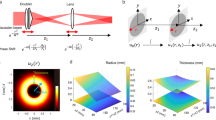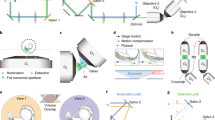Abstract
We implemented two-photon scanned light-sheet microscopy, combining nonlinear excitation with orthogonal illumination of light-sheet microscopy, and showed its excellent performance for in vivo, cellular-resolution, three-dimensional imaging of large biological samples. Live imaging of fruit fly and zebrafish embryos confirmed that the technique can be used to image up to twice deeper than with one-photon light-sheet microscopy and more than ten times faster than with point-scanning two-photon microscopy without compromising normal biology.
This is a preview of subscription content, access via your institution
Access options
Subscribe to this journal
Receive 12 print issues and online access
$259.00 per year
only $21.58 per issue
Buy this article
- Purchase on Springer Link
- Instant access to full article PDF
Prices may be subject to local taxes which are calculated during checkout



Similar content being viewed by others
References
Vermot, J., Fraser, S.E. & Liebling, M. HFSP J. 2, 143–155 (2008).
Denk, W., Strickler, J.H. & Webb, W.W. Science 248, 73–76 (1990).
Siedentopf, H. & Zsigmondy, R. Annalen Der Physik 10, 1–39 (1902).
Huisken, J. & Stainier, D.Y.R. Development 136, 1963–1975 (2009).
Huisken, J., Swoger, J., Del Bene, F., Wittbrodt, J. & Stelzer, E.H.K. Science 305, 1007–1009 (2004).
Keller, P.J., Schmidt, A.D., Wittbrodt, J. & Stelzer, E.H.K. Science 322, 1065–1069 (2008).
Huisken, J. & Stainier, D.Y.R. Opt. Lett. 32, 2608–2610 (2007).
Palero, J., Santos, S., Artigas, D. & Loza-Alvarez, P. Opt. Express 18, 8491–8498 (2010).
Ji, N., Magee, J.C. & Betzig, E. Nat. Methods 5, 197–202 (2008).
Supatto, W., McMahon, A., Fraser, S.E. & Stathopoulos, A. Nat. Protoc. 4, 1397–1412 (2009).
Preibisch, S., Saalfeld, S., Schindelin, J. & Tomancak, P. Nat. Methods 7, 418–419 (2010).
Scherz, P.J., Huisken, J., Sahai-Hernandez, P. & Stainier, D.Y.R. Development 135, 1179–1187 (2008).
Verveer, P.J. et al. Nat. Methods 4, 311–313 (2007).
Keller, P.J. et al. Nat. Methods 7, 637–642 (2010).
Ji, N., Milkie, D.E. & Betzig, E. Nat. Methods 7, 141–147 (2010).
Fahrbach, F.O., Simon, P. & Rohrbach, A. Nat. Photonics 4, 780–785 (2010).
Planchon, T.A. et al. Nat. Methods 8, 417–423 (2011).
Carriles, R. et al. Rev. Sci. Instrum. 80, 081101 (2009).
Pantazis, P., Maloney, J., Wu, D. & Fraser, S.E. Proc. Natl. Acad. Sci. USA 107, 14535–14540 (2010).
Pologruto, T., Sabatini, B. & Svoboda, K. Biomed. Eng. Online 2, 13 (2003).
Edelstein, A., Amodaj, N., Hoover, K., Vale, R. & Stuurman, N. Curr. Protoc. Mol. Biol. 92, 14.20.1–14.20.17 (2010).
Engelbrecht, C.J. & Stelzer, E.H.K. Opt. Lett. 31, 1477–1479 (2006).
Zipfel, W.R., Williams, R.M. & Webb, W.W. Nat. Biotechnol. 21, 1369–1377 (2003).
Beis, D . et al. Development 132, 4193–4204 (2005).
Kopp, R., Schwerte, T. & Pelster, B. J. Exp. Biol. 208, 2123–2134 (2005).
Williams, R.M., Zipfel, W.R. & Webb, W.W. Biophys. J. 88, 1377–1386 (2005).
Acknowledgements
We thank P. Pantazis, W. Dempsey and L. Trinh for help with zebrafish sample preparations, and E. Beaurepaire for comments on the manuscript. This work was supported by grants to S.E.F. from the Caltech Beckman Institute and US National Institutes of Health (Center for Excellence in Genomic Science grant P50HG004071), and a fellowship to W.S. from the Caltech Biology Division.
Author information
Authors and Affiliations
Contributions
T.V.T., W.S. and S.E.F. conceived and designed the project with consultation from D.S.K. and J.M.C.; T.V.T. designed and assembled the instrumentation; J.M.C. provided help with instrument software control. T.V.T. and W.S. imaged flies; T.V.T. imaged zebrafish; T.V.T. and D.S.K. imaged mice; W.S. and T.V.T. performed image reconstruction and analysis, and designed the figures; and T.V.T., W.S. and S.E.F. wrote the paper.
Corresponding authors
Ethics declarations
Competing interests
T.V.T., W.S., D.S.K., J.M.C. and S.E.F. have submitted a patent on the technology of multiphoton light-sheet microscopy (US patent application 12/915,921; international patent application PCT/US2010/054760).
Supplementary information
Supplementary Text and Figures
Supplementary Figures 1–9, Supplementary Table 1, Supplementary Results 1–5, Supplementary Discussion 1–4 (PDF 2617 kb)
Supplementary Video 1
Animated depiction of the bidirectional scanned light sheet. (MOV 603 kb)
Supplementary Video 2
A 3D view of high and near-isotropic spatial resolution obtained in early fly embryo (stage 5) using 2P-SPIM. A 3D rendering of the raw images obtained with 2P-SPIM (same data as shown in Supplementary Fig. 4a,b,g) using only linear contrast adjustment and without additional image filtering. The 3D rendering uses maximum intensity projection and shows the homogeneous spatial resolution in both x-y and x-z directions. It illustrates that 2P-SPIM can resolve nuclei almost around the entire embryo, even though the imaging was collected from only one view (from the ventral side along the z direction). Grid spacing in movie, 100 μm. (MOV 3316 kb)
Supplementary Video 3
2P-SPIM imaging of entire fly development without photodamage. Representative movie shows 3D-rendered views of the time lapse imaging carried out to test the photodamage of 2P-SPIM imaging with high laser power over the entire fly development. Time-lapse started at stage 5 before gastrulation and ended ~18 h later when the embryo hatched and crawled away. Analysis of these time-lapse data, showing normal development of the embryos, is presented in Figure 3 and Supplementary Figure 7. Embryo anterior pole is to the left. Scale bar, 100 μm. (MOV 9440 kb)
Supplementary Video 4
Comparison of multiview imaging with 2P-SPIM and 1P-SPIM: z-stack view. Data correspond to Supplementary Figure 6. Scale bar, 50 μm. (MOV 6251 kb)
Supplementary Video 5
Comparison of multiview imaging with 2P-SPIM and 1P-SPIM: rotating 3D view. Data correspond to Supplementary Figure 6. Grid spacing in movie, 100 μm. (MOV 7311 kb)
Supplementary Video 6
A 3D reconstruction of entire fly embryo from multiview 2P-SPIM dataset. A 3D rendering after stitching z-stacks acquired from two opposing views as presented in Supplementary Figure 6. Computational cuts show internal structures. Grid spacing in movie, 100 μm. (MOV 2249 kb)
Supplementary Video 7
Fast non-phototoxic 2P-SPIM imaging of live zebrafish beating heart. Transgenic zebrafish with GFP-labeled endocardium, at 5.4 d after fertilization, was imaged at 70 frames s–1, with field of view of 400 pixels × 400 pixels. The heart valve leaflets, and their fast motions, can be seen at the center of the field of view. Analysis of movie, showing lack of phototoxicity, is in Supplementary Figure 8. (MOV 2464 kb)
Rights and permissions
About this article
Cite this article
Truong, T., Supatto, W., Koos, D. et al. Deep and fast live imaging with two-photon scanned light-sheet microscopy. Nat Methods 8, 757–760 (2011). https://doi.org/10.1038/nmeth.1652
Received:
Accepted:
Published:
Issue Date:
DOI: https://doi.org/10.1038/nmeth.1652
This article is cited by
-
Real-time study of spatio-temporal dynamics (4D) of physiological activities in alive biological specimens with different FOVs and resolutions simultaneously
Scientific Reports (2024)
-
HyU: Hybrid Unmixing for longitudinal in vivo imaging of low signal-to-noise fluorescence
Nature Methods (2023)
-
Structural and functional imaging of brains
Science China Chemistry (2023)
-
Multi-focus light-field microscopy for high-speed large-volume imaging
PhotoniX (2022)
-
Practical considerations for quantitative light sheet fluorescence microscopy
Nature Methods (2022)



